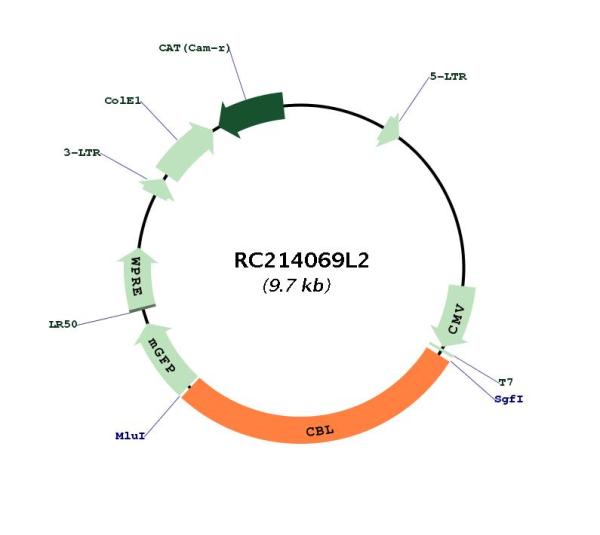CBL (NM_005188) Human Tagged Lenti ORF Clone
CAT#: RC214069L2
- LentiORF®
Lenti ORF clone of Human Cas-Br-M (murine) ecotropic retroviral transforming sequence (CBL), mGFP tagged
"NM_005188" in other vectors (6)
USD 365.00
Specifications
| Product Data | |
| Type | Human Tagged ORF Clone |
| Tag | mGFP |
| Symbol | CBL |
| Synonyms | C-CBL; CBL2; FRA11B; NSLL; RNF55 |
| Vector | pLenti-C-mGFP |
| E. coli Selection | Chloramphenicol (34 ug/mL) |
| Mammalian Cell Selection | None |
| Sequence Data |
The ORF insert of this clone is exactly the same as(RC214069).
|
| Restriction Sites |
SgfI-MluI
Cloning Scheme for this gene
Plasmid Map

|
| ACCN | NM_005188 |
| ORF Size | 2718 bp |
| OTI Disclaimer | Due to the inherent nature of this plasmid, standard methods to replicate additional amounts of DNA in E. coli are highly likely to result in mutations and/or rearrangements. Therefore, OriGene does not guarantee the capability to replicate this plasmid DNA. Additional amounts of DNA can be purchased from OriGene with batch-specific, full-sequence verification at a reduced cost. Please contact our customer care team at custsupport@origene.com or by calling 301.340.3188 option 3 for pricing and delivery. The molecular sequence of this clone aligns with the gene accession number as a point of reference only. However, individual transcript sequences of the same gene can differ through naturally occurring variations (e.g. polymorphisms), each with its own valid existence. This clone is substantially in agreement with the reference, but a complete review of all prevailing variants is recommended prior to use. More info |
| OTI Annotation | This clone was engineered to express the complete ORF with an expression tag. Expression varies depending on the nature of the gene. |
| Product Components | The ORF clone is ion-exchange column purified and shipped in a 2D barcoded Matrix tube containing 10ug of transfection-ready, dried plasmid DNA (reconstitute with 100 ul of water). |
| Reconstitution | 1. Centrifuge at 5,000xg for 5min. 2. Carefully open the tube and add 100ul of sterile water to dissolve the DNA. 3. Close the tube and incubate for 10 minutes at room temperature. 4. Briefly vortex the tube and then do a quick spin (less than 5000xg) to concentrate the liquid at the bottom. 5. Store the suspended plasmid at -20°C. The DNA is stable for at least one year from date of shipping when stored at -20°C. |
| Reference Data | |
| RefSeq | NM_005188.2 |
| RefSeq Size | 11242 bp |
| RefSeq ORF | 2721 bp |
| Locus ID | 867 |
| UniProt ID | P22681 |
| Cytogenetics | 11q23.3 |
| Domains | UBA, RING, Cbl_N |
| Protein Families | Druggable Genome, Transcription Factors |
| Protein Pathways | Chronic myeloid leukemia, Endocytosis, ErbB signaling pathway, Insulin signaling pathway, Jak-STAT signaling pathway, Pathways in cancer, T cell receptor signaling pathway, Ubiquitin mediated proteolysis |
| MW | 99.5 kDa |
| Gene Summary | This gene is a proto-oncogene that encodes a RING finger E3 ubiquitin ligase. The encoded protein is one of the enzymes required for targeting substrates for degradation by the proteasome. This protein mediates the transfer of ubiquitin from ubiquitin conjugating enzymes (E2) to specific substrates. This protein also contains an N-terminal phosphotyrosine binding domain that allows it to interact with numerous tyrosine-phosphorylated substrates and target them for proteasome degradation. As such it functions as a negative regulator of many signal transduction pathways. This gene has been found to be mutated or translocated in many cancers including acute myeloid leukaemia, and expansion of CGG repeats in the 5' UTR has been associated with Jacobsen syndrome. Mutations in this gene are also the cause of Noonan syndrome-like disorder. [provided by RefSeq, Jul 2016] |
Documents
| Product Manuals |
| FAQs |
| SDS |
Resources
Other Versions
| SKU | Description | Size | Price |
|---|---|---|---|
| RC214069 | CBL (Myc-DDK-tagged)-Human Cas-Br-M (murine) ecotropic retroviral transforming sequence (CBL) |
USD 1,244.00 |
|
| RC214069L1 | Lenti ORF clone of Human Cas-Br-M (murine) ecotropic retroviral transforming sequence (CBL), Myc-DDK-tagged |
USD 1,544.00 |
|
| RC214069L3 | Lenti ORF clone of Human Cas-Br-M (murine) ecotropic retroviral transforming sequence (CBL), Myc-DDK-tagged |
USD 1,544.00 |
|
| RC214069L4 | Lenti ORF clone of Human Cas-Br-M (murine) ecotropic retroviral transforming sequence (CBL), mGFP tagged |
USD 1,544.00 |
|
| RG214069 | CBL (tGFP-tagged) - Human Cas-Br-M (murine) ecotropic retroviral transforming sequence (CBL) |
USD 1,444.00 |
|
| SC123872 | CBL (untagged)-Human Cas-Br-M (murine) ecotropic retroviral transforming sequence (CBL) |
USD 1,245.00 |
{0} Product Review(s)
Be the first one to submit a review






























































































































































































































































 Germany
Germany
 Japan
Japan
 United Kingdom
United Kingdom
 China
China

